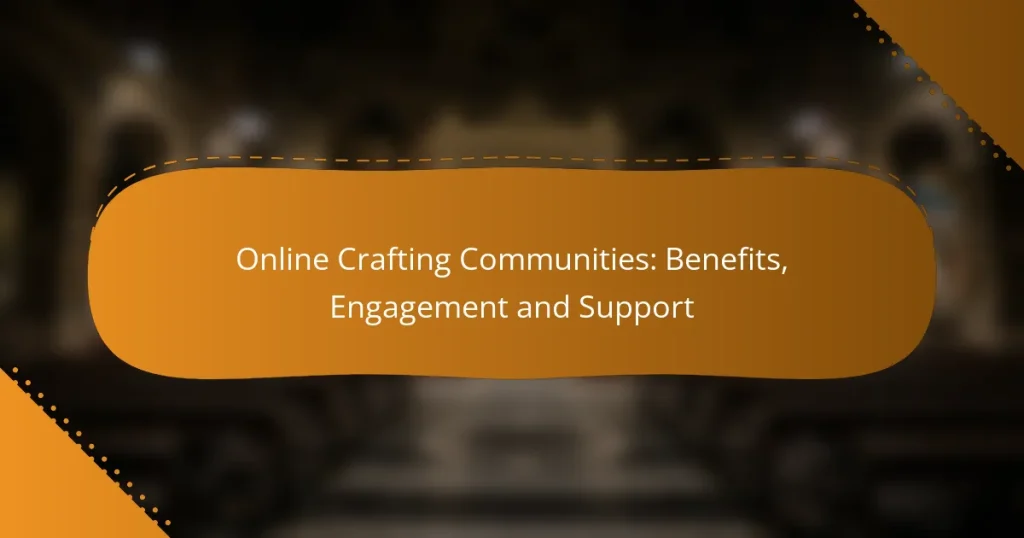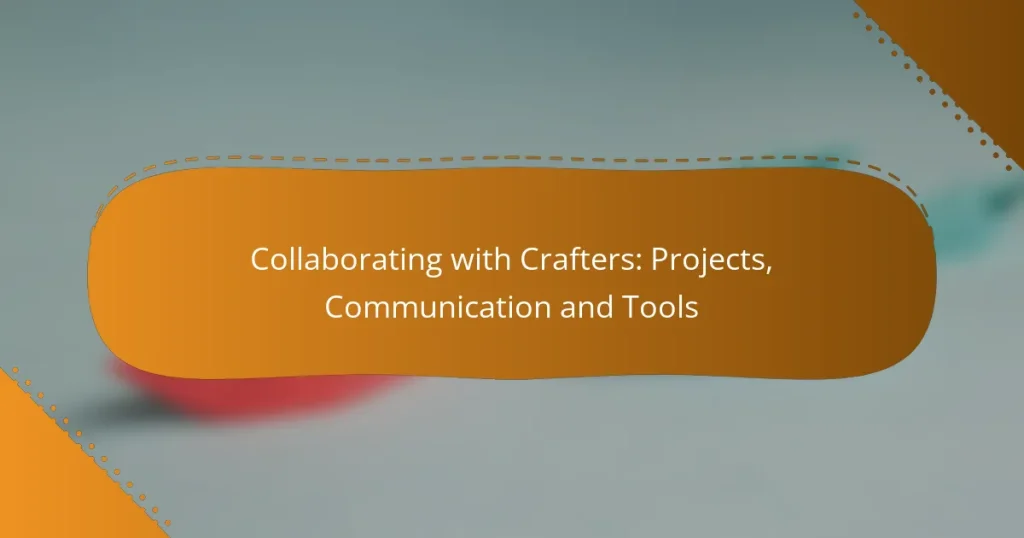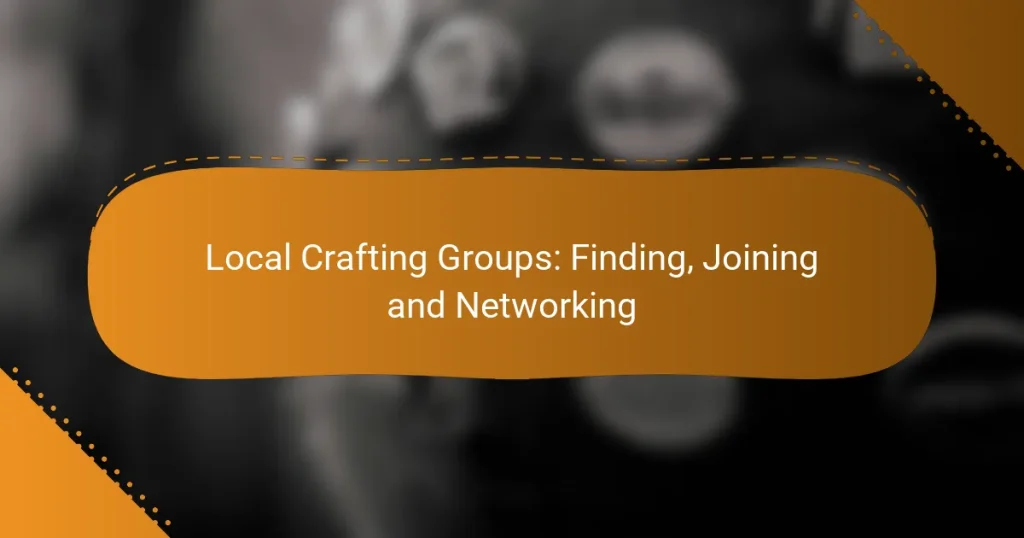Crafting vibrant online communities requires intentional design that encourages connection, collaboration, and sharing among members. By focusing on engagement, providing valuable resources, and setting clear guidelines, community managers can create a positive and productive environment. Additionally, utilizing essential tools for communication and analytics can enhance the overall experience and facilitate growth.
Online Crafting Communities: Benefits, Engagement and Support
Crafting Events: Fairs, Workshops and Networking Opportunities
Collaborating with Crafters: Projects, Communication and Tools
Local Crafting Groups: Finding, Joining and Networking
Crafting Challenges: Participation, Benefits and Community
Learning Crafting Techniques: Resources, Courses and Tutorials
How to build effective online communities?
Building effective online communities involves creating engaging spaces where members can connect, share, and collaborate. Focus on fostering interaction, providing valuable resources, and establishing clear guidelines to ensure a positive environment.
Utilize platforms like Discord
Discord is a versatile platform ideal for real-time communication and community building. Its features, such as voice channels, text chat, and integration with games, make it appealing for diverse groups.
To maximize engagement, create dedicated channels for specific topics and encourage members to participate in discussions. Regular events, like game nights or Q&A sessions, can help maintain interest and foster connections.
Leverage Facebook Groups
Facebook Groups offer a familiar environment for users to connect and share content. They are particularly effective for niche communities, allowing members to post updates, ask questions, and share resources.
To enhance group dynamics, set clear rules and actively moderate discussions. Consider using polls to gauge member interests and organize virtual meetups to strengthen relationships.
Engage through Reddit communities
Reddit communities, or subreddits, provide a platform for discussions around specific interests. They are excellent for gathering feedback, sharing knowledge, and connecting with like-minded individuals.
To engage effectively, participate actively by responding to comments and sharing valuable content. Be mindful of subreddit rules and culture to ensure your contributions are well-received and foster a positive atmosphere.
What resources are essential for community management?
Essential resources for community management include tools for engagement, content creation, and analytics. These resources help streamline communication, enhance content quality, and provide insights into community behavior.
Community management tools like Tribe
Community management tools like Tribe facilitate the creation and maintenance of online communities. They offer features such as discussion forums, member profiles, and event calendars, which help foster engagement among members.
When selecting a community management tool, consider factors like user interface, integration capabilities with other platforms, and scalability to accommodate growth. A tool that allows customization can enhance the community’s unique identity.
Content creation resources such as Canva
Content creation resources like Canva enable community managers to design visually appealing graphics and promotional materials easily. With a user-friendly interface, Canva offers templates for social media posts, flyers, and presentations, making it accessible for users with varying design skills.
Utilizing content creation tools can significantly enhance the quality of your community’s visual content. Aim for consistency in branding by using similar color schemes and fonts across all materials to strengthen community identity.
Analytics tools like Google Analytics
Analytics tools like Google Analytics provide valuable insights into community engagement and behavior. These tools track metrics such as user visits, page views, and interaction rates, helping managers understand what content resonates with their audience.
When using analytics tools, focus on key performance indicators (KPIs) relevant to your community goals, such as member growth and engagement rates. Regularly reviewing these metrics can inform strategies for improving community interaction and content relevance.
How to monetize online communities?
Monetizing online communities involves leveraging their engagement and size to generate revenue through various strategies. Key methods include affiliate marketing, membership subscriptions, and sponsored content, each offering unique benefits and considerations.
Affiliate marketing partnerships
Affiliate marketing partnerships allow community owners to earn commissions by promoting products or services relevant to their audience. By joining affiliate programs, you can share unique links and earn a percentage of sales generated through those links.
To maximize success, choose products that align with your community’s interests. For example, a fitness community might partner with health supplement brands. Be transparent about affiliate relationships to maintain trust with your members.
Membership subscription models
Membership subscription models involve charging users a recurring fee for access to exclusive content, resources, or community features. This could range from a few dollars to higher amounts, depending on the value offered.
Consider offering tiered memberships to cater to different budgets and engagement levels. For instance, a basic tier might provide access to a forum, while a premium tier offers one-on-one coaching or exclusive webinars. Ensure that the benefits justify the cost to retain subscribers.
Sponsored content opportunities
Sponsored content opportunities involve collaborating with brands to create content that promotes their products while providing value to your community. This can include blog posts, videos, or social media posts that feature the sponsor’s offerings.
When pursuing sponsorships, ensure that the brands align with your community’s values and interests. Clearly disclose sponsored content to maintain transparency. A good practice is to limit sponsored posts to maintain authenticity and avoid overwhelming your audience with advertisements.
What are the best practices for fostering engagement?
To foster engagement effectively, focus on creating an inclusive environment that encourages participation and interaction. Implementing structured activities and open communication channels can significantly enhance community involvement.
Regular interactive events
Hosting regular interactive events is crucial for maintaining community engagement. These can include workshops, webinars, or social gatherings that allow members to connect and collaborate. Aim for a mix of online and offline events to cater to diverse preferences.
Consider scheduling events at different times to accommodate various time zones and lifestyles. For instance, hosting a monthly virtual meetup and quarterly in-person events can help maximize participation.
Feedback loops for community input
Establishing feedback loops is essential for understanding community needs and preferences. Regularly solicit input through surveys, polls, or open forums, allowing members to voice their opinions and suggestions. This not only fosters a sense of ownership but also helps tailor offerings to better suit the community.
Make it easy for members to provide feedback by using simple tools like Google Forms or dedicated feedback channels on your platform. Ensure that you act on the feedback received to demonstrate that member input is valued.
Personalized communication strategies
Personalized communication strategies enhance engagement by making members feel recognized and valued. Use data insights to tailor messages based on individual interests and past interactions. This could involve segmenting your audience and sending targeted emails or notifications.
Additionally, consider using member names in communications and acknowledging milestones, such as anniversaries or achievements. This personal touch can significantly improve member satisfaction and retention.
What criteria should be considered when selecting community platforms?
When selecting community platforms, it’s essential to evaluate user demographics, integration capabilities, and scalability. These criteria ensure that the platform meets the needs of your audience and can grow alongside your community.
User demographics and preferences
Understanding user demographics is crucial for selecting the right community platform. Consider factors such as age, location, and interests, as these will influence how users engage with the platform. For example, platforms like Discord may appeal more to younger audiences, while Facebook Groups might attract a broader age range.
Gathering feedback through surveys or polls can help identify user preferences. This information can guide you in choosing features that resonate with your community, such as forums, chat options, or multimedia sharing capabilities.
Integration capabilities with existing tools
Integration capabilities are vital for ensuring a seamless user experience. Check if the community platform can connect with tools your community already uses, such as CRM systems, email marketing services, or social media channels. This can streamline communication and enhance engagement.
For instance, platforms that integrate with tools like Slack or Zoom can facilitate real-time discussions and virtual meetings, making it easier for members to connect. Evaluate the availability of APIs or third-party integrations to maximize functionality.
Scalability for future growth
Scalability is a key consideration when selecting a community platform. Choose a platform that can accommodate growth, whether that means handling an increasing number of users or expanding features as your community evolves. Look for platforms that offer tiered pricing or customizable options to support your needs over time.
For example, platforms like Mighty Networks allow you to start small and add features as your community grows, while others may require a complete migration if you outgrow their capabilities. Assess your long-term goals and ensure the platform can adapt accordingly.
How to measure community success?
Measuring community success involves tracking various metrics that reflect engagement, growth, and satisfaction. Key indicators include participation rates, feedback quality, and the overall impact on your organization’s goals.
Engagement metrics tracking
Engagement metrics tracking is essential for understanding how active and involved your community members are. Common metrics include the number of posts, comments, likes, and shares across platforms, which can help gauge member interaction and interest.
To effectively track these metrics, utilize tools like Google Analytics or social media insights. Set specific goals, such as increasing engagement by a certain percentage over a quarter, to measure progress. Regularly review these metrics to identify trends and areas for improvement.
Consider creating a simple dashboard that consolidates key engagement metrics. This can include a mix of quantitative data, like the average number of comments per post, and qualitative feedback, such as member satisfaction ratings. Regularly updating this dashboard will help you make informed decisions about community initiatives.






